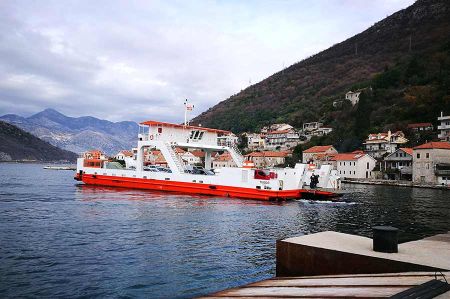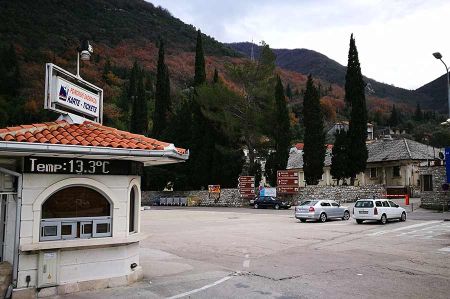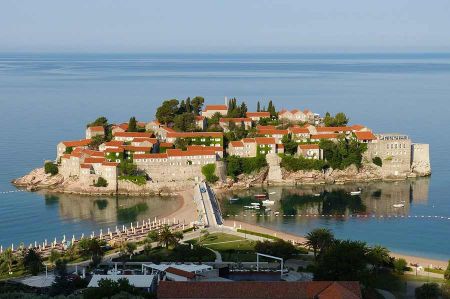After the really informative and family-oriented days with the Bralic family in Solin, the extensive visit to Diocletian's Palace, the Roman aqueduct and the ancient ruins of Salona, we continue our tour along Roman roads towards Lake Ohrid in Macedonia.
Without returning to the motorway (the tolls were simply too high for us), we chose coastal road no. to continue our journey from Split towards Dubrovnik.
Behind Gruda we pass the border of Montenegro
 We are in no hurry as we had already registered for the next overnight stay at a campsite near Budva in Montenegro.
We are in no hurry as we had already registered for the next overnight stay at a campsite near Budva in Montenegro.
Although the coastal road stretches almost endlessly because it only has two lanes, it is easy to drive at this time of year due to the low volume of traffic. Shortly after the town of Opuzen we have to leave Croatia for about 10 kilometres because the journey towards Dubrovnik leads through the territory of Bosnia-Herzegovina.
Of course, with all the usual border controls. It's strange how man-made borders create situations that no one would have ever suspected.
 A serious traffic accident on the narrow road along the bay from Klek in Croatia to Neum in Bosnia-Herzegovina results in a break of about an hour because it is impossible to turn between the swampy reed areas and the coastal canal.
A serious traffic accident on the narrow road along the bay from Klek in Croatia to Neum in Bosnia-Herzegovina results in a break of about an hour because it is impossible to turn between the swampy reed areas and the coastal canal.
So, there is no alternative to waiting until the road is cleared again. A little later we left Bosnia-Herzegovina and only passed through Dubrovnik because we planned to spend a few days here next year. Shortly after Gruda we pass the border of Montenegro. On the E65 we now follow the coastal road to Bijela, where a little later we use the Lepetani - Kamenari ferry to avoid the journey along the huge bay surrounded by high mountains. We knew from Robi that we would miss out on a beautiful scenic route, but would also save 2 - 3 hours of driving time.
Budva is one of the oldest cities on the Adriatic
It is already evening when we reach the city of Budva and thus the destination of today's day tour. Budva is one of the oldest cities on the Adriatic; according to myth, the place was once founded by Cadmus, a son of the Greek Phoenician king Agenor.
From the 10th century BC, Budva was a colony of Greek settlers. In the 4th century the city is mentioned in documents as an Illyrian settlement before it came under Roman rule in the 2nd century.
The old town was originally on an island, but is now connected to the mainland by sandbanks.
The entire old town was almost completely destroyed during the earthquake in 1979 and was reconstructed stone by stone in the Venetian style according to plans from Austrian archives. Budva belonged to the Republic of Venice from 1442 until it was attacked and plundered by Ottomans in the 16th century. With the fall of the Republic of Venice, Budva became part of Austria until the First World War, which is why planning documents were available in the Austrian archives. Only in 1813 was Budva part of the Montenegrin sphere of influence. Today the famous old town is once again completely surrounded by a medieval city wall and is therefore an attraction for tourists from many countries, which can easily be seen from some of the mighty hotel castles. Budva is an attractive seaside resort. However, the old town is under monument protection.
We initially had problems finding the campsite because we simply overlooked the narrow driveway. The owner, who we had already called from Croatia to book, speaks German quite well, but her explanation of how to find the entrance was incorrect and the navigation system wasn't of any real help either. Since the road climbed continuously and in serpentines after leaving the city, the first step was to find a way to turn around. But this was also successful and a little later we arrived at the campsite, where we were already expected. After a restful night, we should continue towards Albania the next morning.
We left Budva on the E80, a road that goes really high near Petrovac and winds violently into the mountains towards Podgorica. Since it was raining heavily on the coast, we weren't sure if it would snow up in the mountains. Although we were equipped with winter tires, we didn't necessarily want to take the risk. We had heard from truck drivers that there would be a new road tunnel that would lead less difficultly towards Podgorica. So, we continued to follow the E80 towards Sutomore and then automatically reached the approximately 6-kilometre-long road tunnel. A good decision.
Shortly after Podgorica the E762 took us towards the border with Albania. At times we were no longer sure whether we were really on the right path. No traffic, the road can sometimes be compared to a poorly paved dirt road. Is this supposed to be a European route? Well, we finally reached the border station along the lakeshore. The usual formalities were quickly completed and we were on our way to Shkoder and Tirana. Surprisingly well-developed roads made it possible to make good progress all the way to the capital Tirana... Confusing traffic, heavy traffic with a wide variety of vehicle types and poor signage also meant that we were misdirected into an industrial area, where we initially lost our bearings. So back to the main road and continue using the compass direction on the navigation system. At some point suddenly there is a sign pointing towards Elbasan. Rescued.
Route of the Roman road Via Egnatia
With the town of Elbasan we had also reached the route of the Roman road Via Egnatia, which once connected ancient Rome with Constantinople or Byzantium. The starting point of the Via Egnatia was the port city of Durres, which in the Roman Empire was considered an important trading point for goods from the Roman provinces of Anatolia with Rome. From Dürres this route led first to Elbasan, then along the Shkumbin River to Lake Ohrid, from here via Struga, Ohrid and Bitola towards Edessa in Greece. We followed this ancient route with our caravan through some fascinating landscapes. The Shkumbin and the valley appear partly untouched by progress, although a new road route is also under construction here. We can already easily empathize with Marietta van Attekum's descriptions of the hikes along the Via Egnatia. It must be wonderful to hike this valley on foot. Our current destination, however, is Struga on Lake Ohrid, where we have registered at a small private campsite.
So, we continue to follow the E852 to the border station between Albania and Macedonia, high up in the mountains (41°05'24.7"N 20°36'27.6"E). The controls here also run smoothly and so we go down to Lake Ohrid, whose water level is already 695 meters above sea level. We are excited about the campsite, which is a family business, and, as is so often the case, we are not disappointed. Directly on the lakeshore with a small restaurant and a family welcome, there is the first Macedonian mocha.
Please read as well:
Pasha - a "significant" title in the Ottoman Empire
Nepomuk – not just a well-known dragon that no one wants


